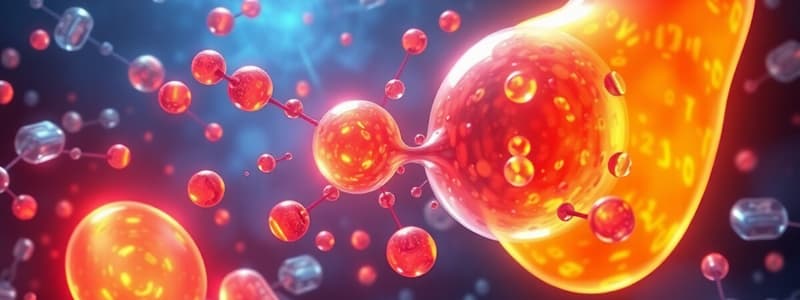Podcast
Questions and Answers
What is the primary mechanism by which opioids relieve pain?
What is the primary mechanism by which opioids relieve pain?
- Enhancing peripheral nerve regeneration
- Inhibiting the reuptake of serotonin
- Increasing the efficacy of neurotransmission
- Binding to G-protein coupled receptors (correct)
Which of the following is classified as a semi-synthetic opioid?
Which of the following is classified as a semi-synthetic opioid?
- Tramadol (correct)
- Codeine
- Morphine
- Pethidine
What is a common CNS effect associated with certain medications?
What is a common CNS effect associated with certain medications?
- Tinnitus
- Tarry stool
- Renal failure
- Sedation (correct)
Which of the following is a potential GI effect of certain drugs?
Which of the following is a potential GI effect of certain drugs?
Which type of opioid is Methadone categorized under?
Which type of opioid is Methadone categorized under?
What effect does post-synaptic receptor activation have in opioid analgesics?
What effect does post-synaptic receptor activation have in opioid analgesics?
What condition is NOT listed as a use for NSAIDs?
What condition is NOT listed as a use for NSAIDs?
Which of the following is NOT an example of an opioid agonist?
Which of the following is NOT an example of an opioid agonist?
Which of the following is true about narcotics?
Which of the following is true about narcotics?
What is a common side effect of opioid analgesics?
What is a common side effect of opioid analgesics?
What adverse effect is associated with the use of certain medications affecting the kidneys?
What adverse effect is associated with the use of certain medications affecting the kidneys?
What is a known adverse effect that may occur in patients taking narcotics?
What is a known adverse effect that may occur in patients taking narcotics?
Which of these functions is inhibited through pre-synaptic receptor activation by opioids?
Which of these functions is inhibited through pre-synaptic receptor activation by opioids?
Which category do NSAIDs fall under?
Which category do NSAIDs fall under?
Which statement about NSAIDs is correct?
Which statement about NSAIDs is correct?
Where are opioid receptors predominantly located?
Where are opioid receptors predominantly located?
What is the primary indication for the use of ergotamine?
What is the primary indication for the use of ergotamine?
Which of the following is a monitored adverse effect of ergotamine?
Which of the following is a monitored adverse effect of ergotamine?
How does ergotamine act on cranial blood vessels?
How does ergotamine act on cranial blood vessels?
What is the half-life of ergotamine?
What is the half-life of ergotamine?
What is the primary goal of anesthesia?
What is the primary goal of anesthesia?
What is the principal therapeutic use of methadone?
What is the principal therapeutic use of methadone?
Which of the following describes the mechanism of action (MOA) of hydromorphone?
Which of the following describes the mechanism of action (MOA) of hydromorphone?
What is a unique characteristic of remifentanil compared to other opioids?
What is a unique characteristic of remifentanil compared to other opioids?
What is the primary use of oxymorphone?
What is the primary use of oxymorphone?
What pharmacologic effect does pethidine have aside from analgesia?
What pharmacologic effect does pethidine have aside from analgesia?
Which opioid has a mechanism of action as a u-agonist similar to morphine?
Which opioid has a mechanism of action as a u-agonist similar to morphine?
In what way does methadone abstinence syndrome differ from morphine abstinence syndrome?
In what way does methadone abstinence syndrome differ from morphine abstinence syndrome?
Which synthetic opioid is primarily used for surgeries including craniotomies and cardiac surgery?
Which synthetic opioid is primarily used for surgeries including craniotomies and cardiac surgery?
What effect do large doses of aspirin have on uric acid levels?
What effect do large doses of aspirin have on uric acid levels?
What is a common adverse effect associated with NSAIDs?
What is a common adverse effect associated with NSAIDs?
Which medication class is known for its uricosuric effect?
Which medication class is known for its uricosuric effect?
What is a potential effect of long-term NSAID use on the blood?
What is a potential effect of long-term NSAID use on the blood?
What is a contraindication regarding NSAIDs during pregnancy?
What is a contraindication regarding NSAIDs during pregnancy?
What is the typical time frame for NSAIDs to peak in the body?
What is the typical time frame for NSAIDs to peak in the body?
Which of the following is NOT a use for NSAIDs?
Which of the following is NOT a use for NSAIDs?
What is a mild toxic reaction that may occur from salicylate use?
What is a mild toxic reaction that may occur from salicylate use?
Flashcards are hidden until you start studying
Study Notes
Opioid Mechanism of Action
- Opioids primarily relieve pain by binding to opioid receptors in the central nervous system (CNS) and reducing the perception of pain.
Opioid Classification
- Semi-synthetic opioids are derived from naturally occurring opioids and modified chemically. Examples include heroin and oxycodone.
CNS Effects of Medications
- A common CNS effect associated with certain medications is drowsiness.
GI Effects of Medications
- A potential GI effect of certain drugs is constipation.
Methadone Category
- Methadone is categorized as a synthetic opioid.
Post-Synaptic Receptor Activation
- Post-synaptic receptor activation in opioid analgesics results in the reduction of pain perception by inhibiting the release of neurotransmitters involved in pain signaling.
NSAID Uses
- NSAIDs (Nonsteroidal Anti-inflammatory Drugs) are NOT typically used to treat bacterial infections.
Opioid Agonist Examples
- Naloxone is NOT an example of an opioid agonist, it’s an antagonist.
Narcotic Characteristics
- Narcotics are a class of drugs that have analgesic properties and can cause euphoria and dependence.
Opioid Analgesics Side Effects
- A common side effect of opioid analgesics is constipation.
Kidney-Related Adverse Effects
- An adverse effect associated with certain medications affecting the kidneys is renal impairment.
Narcotic Adverse Effect
- A known adverse effect that may occur in patients taking narcotics is respiratory depression.
Pre-Synaptic Receptor Activation by Opioids
- Pre-synaptic receptor activation by opioids inhibits the release of neurotransmitters, such as substance P and glutamate, which are involved in pain transmission.
NSAID Classification
- NSAIDs belong to the category of nonsteroidal anti-inflammatory drugs.
NSAID Properties
- NSAIDs are known for their ability to reduce inflammation, relieve pain, and reduce fever.
Opioid Receptor Location
- Opioid receptors are predominantly located in the central nervous system (CNS), specifically in the brain and spinal cord.
Ergotamine Indication
- The primary indication for the use of ergotamine is the treatment of migraine headaches.
Ergotamine Adverse Effect
- A monitored adverse effect of ergotamine use is peripheral vasoconstriction, which can lead to problems in the extremities.
Ergotamine Mechanism of Action
- Ergotamine acts on cranial blood vessels by constricting them, which helps to reduce the pain associated with migraines.
Ergotamine Half-life
- Ergotamine has a half-life of approximately 2 hours.
Anesthesia Goal
- The primary goal of anesthesia is to induce a reversible loss of consciousness and pain sensation.
Methadone Therapeutic Use
- The principal therapeutic use of methadone is the management of opioid dependence.
Hydromorphone MOA
- Hydromorphone exerts its analgesic effect through activation of mu-opioid receptors in the CNS.
Remifentanil Uniqueness
- Remifentanil stands out from other opioids due to its rapid onset of action and ultra-short duration of effect.
Oxymorphone Use
- Oxymorphone is primarily used for severe pain management.
Pethidine Pharmacologic Effect
- Aside from analgesia, pethidine also possesses anticholinergic properties that can influence muscle tone and other physiological functions.
Morphine-Like Opioid
- Fentanyl has a mechanism of action as a u-agonist similar to morphine.
Methadone Abstinence Syndrome Difference
- Methadone abstinence syndrome differs from morphine abstinence syndrome in that it usually develops more slowly and is less intense.
Synthetic Opioid for Surgeries
- Fentanyl is a synthetic opioid chiefly employed for surgeries, including craniotomies and cardiac surgery.
Aspirin on Uric Acid Levels
- Large doses of aspirin can elevate uric acid levels in the body.
NSAID Common Adverse Effect
- A common adverse effect associated with NSAIDs is gastric upset, including heartburn and ulcers.
Uricosuric Medication Class
- Probenecid is known for its uricosuric effect, aiding in the excretion of uric acid from the body.
Long-Term NSAID Effect on Blood
- Long-term NSAID use can potentially reduce platelet aggregation and increase the risk of bleeding.
NSAID Contraindication in Pregnancy
- NSAIDs are generally contraindicated during the third trimester of pregnancy, as they can lead to complications for both mother and fetus.
NSAID Peak Time
- NSAIDs typically reach their peak concentration in the body within 1-2 hours after administration.
NSAID Use Exclusions
- NSAIDs are NOT recommended for the treatment of viral infections.
Salicylate Toxic Reaction
- A mild toxic reaction from salicylate use can manifest as tinnitus or ringing in the ears.
Studying That Suits You
Use AI to generate personalized quizzes and flashcards to suit your learning preferences.




